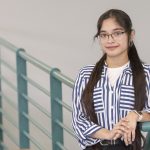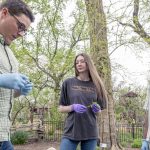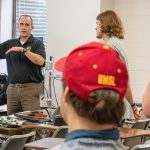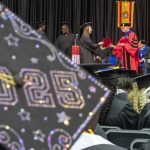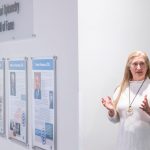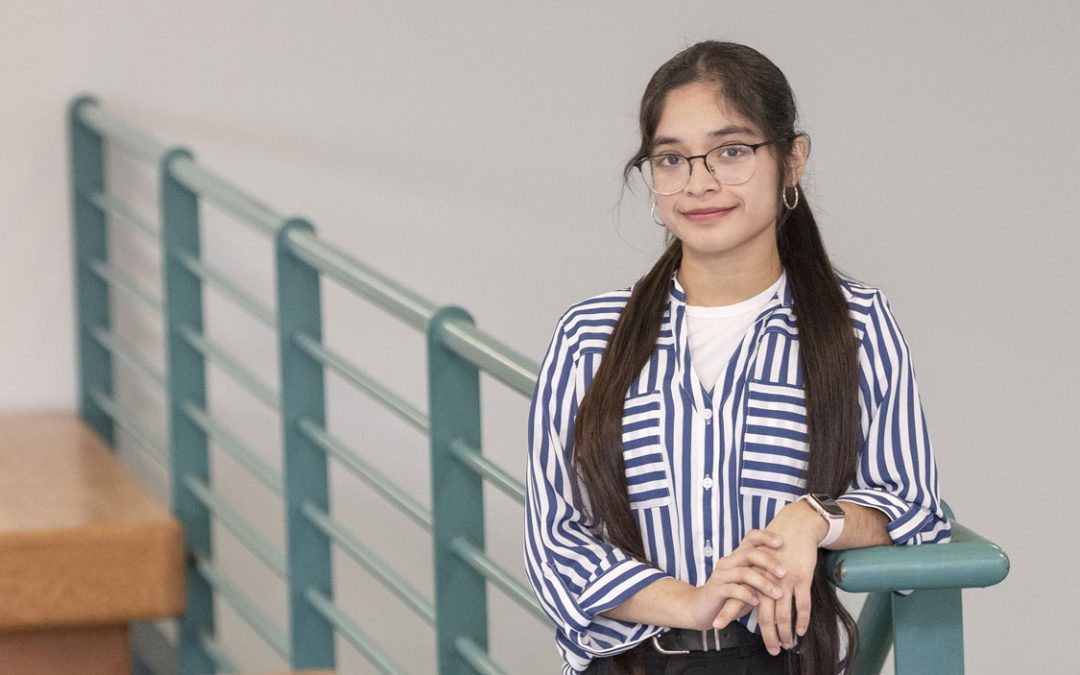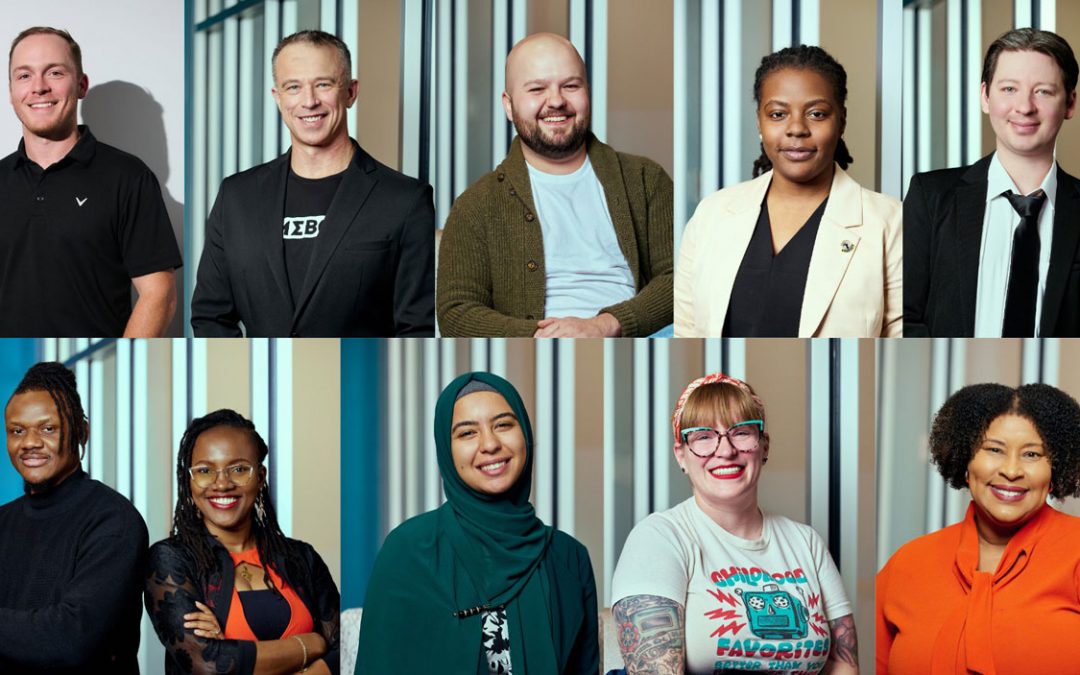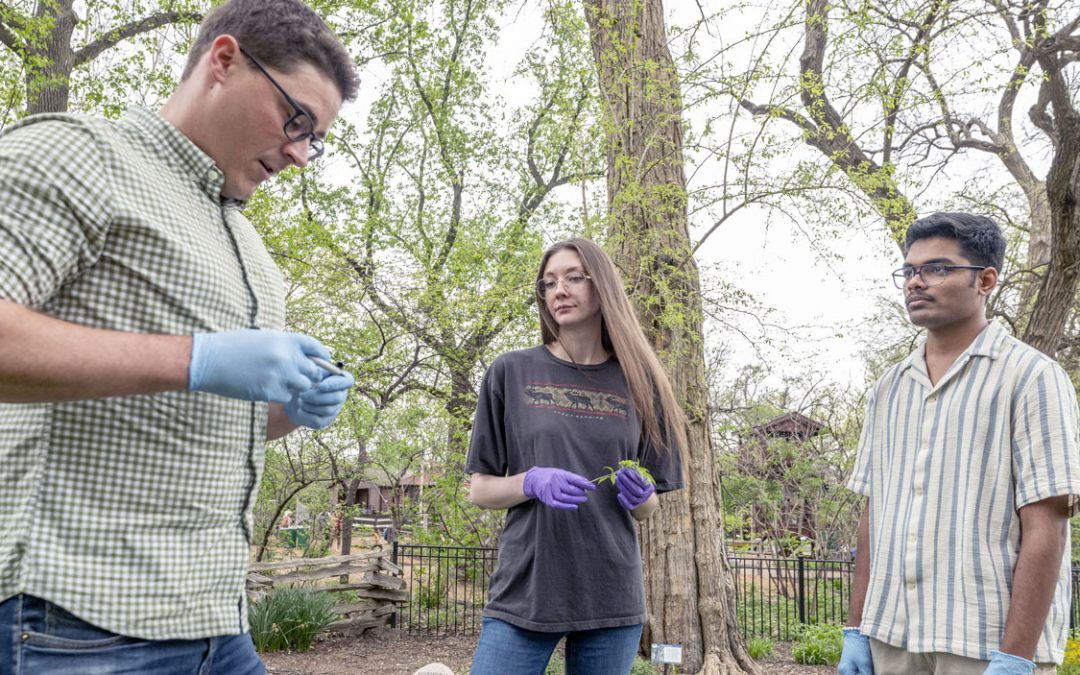
Ruman Singh (right) poses for a picture with his mentor, Professor Sanjiv Bhatia, after the spring commencement ceremony. (Photos by Derik Holtmann)
Ruman Singh was working for investment bank UBS as a robotics process automation engineer when he decided it was time to make a career change.
Singh had already earned his bachelor’s degree in civil engineering and a master’s degree in mathematics from the prestigious Birla Institute of Technology And Science–Pilani, one of the top schools in India, but the type of change he wanted to make meant going back to school again. He’d developed a keen interest in further developing his computer skills while working at UBS – he had experience coding and his background in mathematics made the transition feel natural – so he started exploring his options.
Though he’d never lived outside of India, the reputation of the Department of Computer Science at the University of Missouri–St. Louis caught his eye, and he decided to make the move.
“The program was very good,” Singh said. “I did not have many connections here, but I wanted my master’s from a good university. I like academia. I did not like corporate that much, so I just wanted to shift to academia. And I thought UMSL was a good starting point for that.”
Singh has enjoyed his time at UMSL, and the food scene in St. Louis, so much that he’s sticking around. Singh will soon finish his master’s in computer science – he’s completing his thesis this summer – and has enrolled in the PhD program, which starts in August. He’s earned a graduate certificate in artificial intelligence, and he’s on the verge of completing his degree with a 4.0 GPA.
“My old roommate used to say, sleep is temporary, but grades are forever.” Singh said with a laugh. “So once you get a 4.0 GPA, it’ll stay in your records forever.”
His success in the classroom at UMSL was a change from his experience at BITS Pilani.
“That was a different struggle,” Singh said. “I did learn a lot in my undergrad, but academically, I was not doing that well. I was a lot more mature when I came here and had a much better understanding of what my priorities should be.”
The academic work ethic that has impressed UMSL faculty members is evidence of those realigned priorities. Professor Sanjiv Bhatia nominated Singh for the student marshal honor at the May commencement ceremony, and as part of his nomination, he wrote:
“Rumandeep stands out as a remarkable student with an unyielding commitment to academic achievement. His professors have consistently praised his exceptional performance in the classroom, applauding his profound understanding of complex concepts and his insightful contributions to discussions. He is currently taking a course in computer vision with me, and I have been impressed by his performance and participation in the class.”
With Bhatia’s effusive nomination, Singh was chosen as the student marshal.
“It’s definitely a big honor and it’s definitely going up in my resume,” Singh said. “I actually did not know what a student marshal was until I got it. After that, I asked people, and that’s when I got to know, OK, that’s a big honor.”

Ruman Singh, who has carried a 4.0 GPA throughout his time in the computer science master’s program, was selected as a student marshal at the spring commencement ceremony.
Singh said Bhatia has been a great mentor, always ready with advice for his classwork and his career. Same with other computer science faculty members, including Associate Professor Badri Adhikari, who is his thesis advisor, as well as Assistant Professor Azim Ahmadzadeh and Associate Teaching Professor Mark Hauschild.
Singh has also served as a graduate teaching assistant for multiple courses. That was an experience that expanded his academic perspectives.
“Honestly, my favorite part about it was creating assignments,” Singh said. “It helped me look into a subject. Creating questions was not that easy, I realized. That was a fun job. When you’re a GTA for a course, you learn from a different perspective, which kind of expands your mind because then you have to be absolutely sure about what you are learning.”
In addition to his classes and GTA responsibilities – he completed two modules for Certificate in University Teaching as well as a semester-long workshop for international GTAs to help him prepare for classroom instruction – Singh has been active elsewhere on campus.
“He is a dedicated member and officer of YouthMappers, a student club that promotes geospatial opportunities,” Bhatia wrote in his nomination. “His involvement extends beyond club activities, as he generously volunteered his time as a note-taker for workshops on drone mission planning, LiDAR observation and analysis, and 3D scanning in the Geospatial Collaborative on campus.
“I have been highly impressed by his meticulous attention to detail and his steadfast commitment to serving others. Throughout each workshop day, he diligently took notes, ensuring that every crucial piece of information is captured. At the end of each day, he meticulously transcribed his notes and promptly shared them with the workshop participants. His dedication to providing comprehensive and accessible resources is truly commendable.”
Through his experience with YouthMappers, Singh found – and developed – an affinity for geospatial technologies.
“As the slogan says, it’s a humanitarian organization, and we try to use geospatial data to access all parts of the world,” Singh said. “I’ve been a Student Government Association associate for YouthMappers. I’ve been trying to learn a bit more about geospatial technologies. I did a project for my computer vision class using satellite data to mark wildfires, to help predict wildfires.”
For his project in Bhatia’s computer vision class, Singh used multi-spectral imagery, along with Aerosol data and indices such as Normalized Burn Ratio and Normalized Difference Vegetation Index – which quantifies vegetation greenness – to attempt to predict the potential burn rate for high-risk wildfire areas.
“Basically, I’m using a U-Net model to predict the mask,” Singh said. “It’s actually my first deep-learning project, so I was not expecting amazing results. It’s more like putting my foot in the door.”
Singh wasn’t initially able to replicate the results from relevant published papers but, showing the determination that has marked his UMSL career, he stuck with it and figured out how to make the necessary changes to get the proper output.
As he pursues his doctorate in computer science, Singh says his research focus will include applying computer vision and deep learning to real-world problems. He’s open to career possibilities after his doctoral program, though he’s not getting ahead of himself.
“I would like to get into academia if I can because I really enjoy teaching as well,” he said. “If given the chance, I would definitely try.”


